The forearm is one very confusing and complicated muscle group, which makes the process of selecting appropriate functional forearm exercises even harder. It’s got a lot of different muscles in it that control specific movements like moving your fingers.
Table of Contents
ToggleTraining strong forearms is crucial, not just for daily activities like carrying groceries but also for supporting other muscle groups when holding weight. The last thing you want is for your forearms to give up while doing a deadlift, pull-up, or any exercise that doesn’t target the forearm.
However, having strong forearms is also highly appreciated amongst older adults since it is a great predictor of longevity. According to UCLA and a study from PubMed Central, the use of grip strength can be used as an explanatory or predictive biomarker of specific outcomes such as:
- Generalized strength and function
- Bone mineral density
- Fractures
- Falls
- Nutritional status
- Disease status and comorbidity load
- Cognition
- Depression
- Sleep, hospital-related variables
- Mortality
Based on this study, the measurement of grip strength is highly recommended for older adults and seniors in the community and healthcare settings [1]. That’s why in this article we will go through many exercises that can help you grow strong and reliable forearms.
Start Building Your Dream Body Today
Ready to elevate your fitness game without falling into the trap of dull, repetitive routines that just don’t deliver? Imagine sculpting your ideal physique and boosting your health, all while still enjoying life’s pleasures, like those irresistible weekend getaways and your aunt’s legendary cheesecake. With our online fitness and nutrition coaching service, you don’t have to compromise. Dive into a personalized fitness journey that blends perfectly with your lifestyle, not against it. Book your completely free discovery consultation today, and take the first step towards a transformation that doesn’t require giving up the joys of life.

“I was skeptical about online fitness coaching, but Functional Body Savage completely changed my perspective. Vanja and Radomir’s personalized approach and attention to detail have helped me achieve goals I never thought possible. I’m stronger, more confident, and grateful for their guidance.”
Emily Thompson, San Francisco, CA
Learn More About Our Online Coaching ServiceQuick Summary
- Some of the best functional forearm exercises include wrist curls, reverse wrist curls, wrist rotation, dead hang, farmer’s carry, reverse curls, and more.
- Exercises like wrist curls, reverse wrist curls, and wrist rotation are great for beginners and veterans since you can start with small weights and do them with big weights.
- Exercise like dead hang is good if you don’t have the equipment and if you are into calisthenics.
- Forearms might be just the thing that can save you from death, so train them to be reliable and always ready.
10 Best Functional Forearm Exercises to Improve Your Grip Strength
I will show you different forearm exercises that you can implement in your workout routine.These exercises have been chosen for strengthening your forearms and are appropriate for people of all fitness levels.
Of course, depending on your goals and where you are in your fitness journey, some exercises will fit you better than others.
1. Wrist Curls
Wrist curls are forearm exercises for pure strength. The reason why wrist curls are so effective is because they isolate your forearms almost completely from other muscles.
They target the flexor carpi radialis, the flexor carpi ulnaris, and the palmaris longus, which are all major forearm muscles.
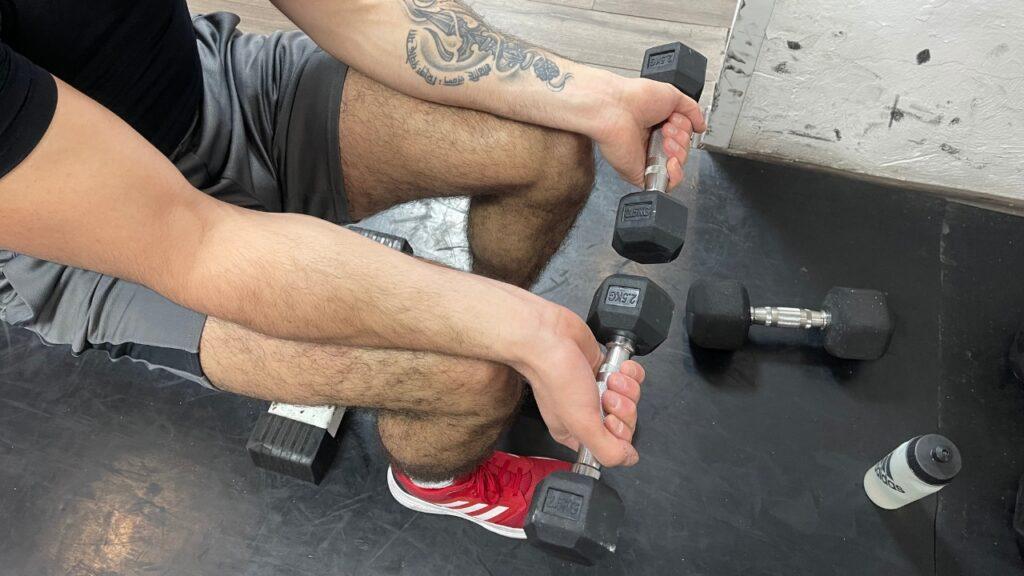
How to Perform Wrist Curls
- Sit on a bench with your legs bent.
- Rest your arms on your legs, holding weights so that the palms of your hands face the ceiling.
- Allow your hands to fall as much as possible, almost with your fingers pointing directly down.
- Lift the weights as high as you can using only forearm muscles.
- Hold for a second at the top, then slowly lower your hands to the starting position.
Wrist curls can be done with a dumbbell or a kettlebell. Any weight you own or that is available in the gym will work.
2. Reverse Wrist Curl
Similar to the wrist curl, reverse wrist curls are another excellent forearm exercise. This exercise isolates various forearm muscles, including the flexor carpi muscles, the brachioradialis, the palmaris longus, the pronator muscles, the flexor digitorum muscles, and the supinator muscles.
Some of these muscles are used for stabilization, direct movement, or flexibility.

How to Perform Reverse Wrist Curls
- Sit on the bench and rest your hands on your legs.
- Grab yourself a pair of dumbbells with an overhand grip.
- Now, curl your dumbbells up as much as possible.
- Hold at the top for a second, then retract your hands to the starting position.
A common mistake people make and why their wrists hurt when they do this exercise is when you move your wrists left or right. They should be moved only up and down. If your wrists hurt while doing the exercise, try doing it with one hand and make sure that your wrist is straight. Avoid lateral movement and adjust your torso position for a better angle.
3. Wrist Rotation
Wrist rotation is a beginner-friendly forearm exercise, ideal for strengthening pronation strength. It’s easy to progressively overload and suitable for beginners as you can start with very low weight and gradually increase [2].

How to Perform Wrist Rotation
- Place a kettlebell on a flat surface with the bottom facing the ceiling.
- Rest your arm on the flat surface and grip the kettlebell handle.
- Rotate the kettlebell to the other side of your hand, using only your forearm for this exercise.
Wrist rotations are an excellent forearm exercise, isolating the forearm for improved grip strength.
4. Dead Hang
Dead hang is an exercise where you hold your body in a stationary position and try to keep it as still as possible. It is a great way to strengthen your overall grip.
I personally do it daily after a set of pull-ups. That way, I maximize my effectiveness, and I don’t waste a lot of time. This exercise targets forearm flexors, important muscles for hand grip strength.
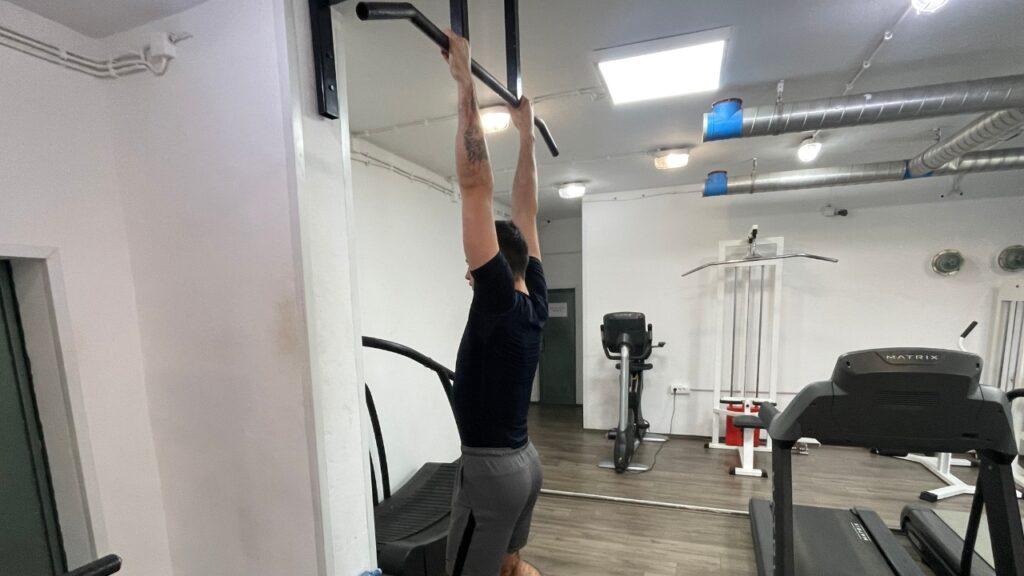
How to Perform Dead Hang
- Stand on your toes under the pull-up bar, raising your hands as close to the bar as possible.
- Grab the bar, jump if necessary, engage your core, and squeeze your hands.
- Hang as still as possible for as long as you can.
If normal dead hang is not a challenge, then you should try one arm dead hang. It’s the same exercise but with one arm at a time. Make sure to do both arms to avoid making muscle imbalances.
Another variation that is a lot more challenging is with your fists, and here’s how to do it:
- Stand under the pull-up bar, raising your hands as close to the bar as possible, but this time, don’t have open hands; close them and make a fist.
- Place your fists over the bar and make a hook with your arm.
- Start hanging and push your fist towards your head, to the inside, towards your arms to keep hanging.
5. Farmer’s Carry/Walk
Farmer’s carry activates almost all muscle groups in your body simultaneously, making it a great forearm exercise as well. Farmer walks primarily target the forearm flexors, such as the flexor digitorum superficialis and flexor digitorum profundus.
Other than forearms, farmer’s carry targets your biceps, triceps, shoulders, upper back, trapezius, quadriceps, hamstrings, and more.
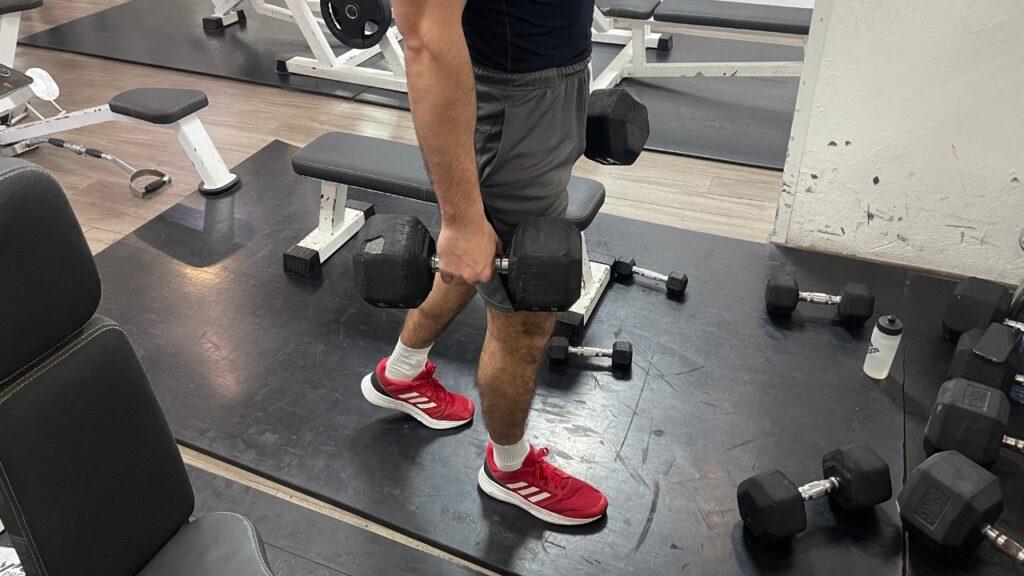
How to Perform Farmer’s Carry
- Stand with your feet hip-width apart between two weights of any kind.
- Brace your core, extending your hips and knees to stand with arms fully extended and weights by your sides.
- Walk forward, taking small steps, and aim to move the weights as little as possible.
- Preventing lateral movement in the frontal plane is crucial to making this exercise as effective as possible.
Also, ensure a controlled and steady pace during the walk to maximize the engagement of forearm muscles.
6. Reverse Curls
Reverse curls, a variation of bicep curls, engage the forearms by lifting the weight with an overhand grip and palms facing down. This shift in technique places increased focus on the brachioradialis muscle.
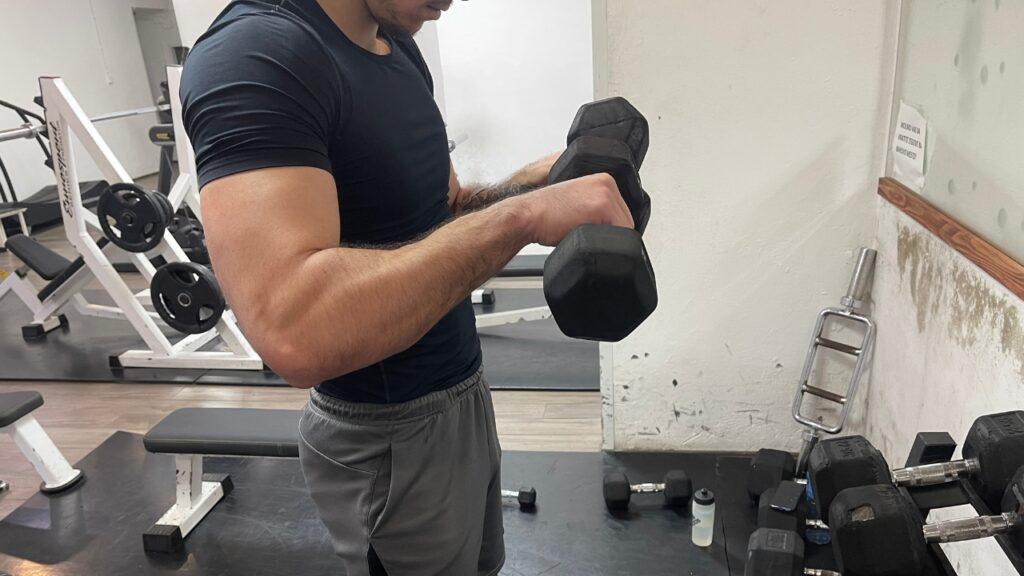
How to Perform Reverse Curls
- Stand upright with a straight back, shoulders back, and chest lifted.
- Take the weights with a pronated grip, palms facing down, resting them on your thighs.
- Curl the weights up to your shoulders, bending your elbows.
- Hold at the top for a second, then lower the weights to the starting position.
Performing reverse curls may lead to wrist discomfort; to avoid this, consider using an EZ bar or dumbbell. This choice provides better wrist flexibility during the motion.
7. Hammer Curls
Hammer curls are a variation of bicep curls, targeting the brachioradialis, a key forearm muscle.
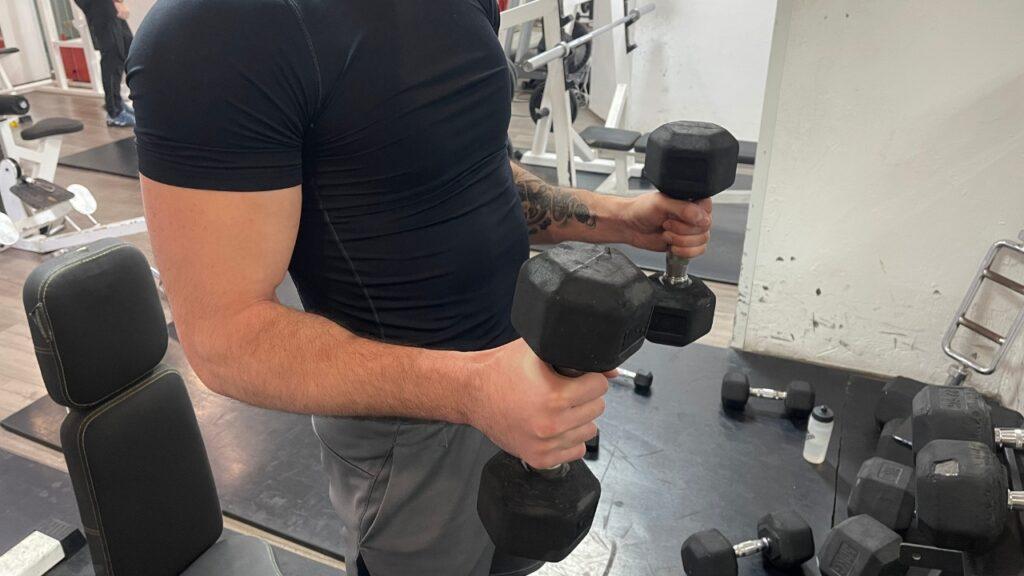
How to Perform Hammer Curls
- Stand straight with legs hip-width apart.
- Grab a pair of dumbbells, starting with a lower weight and increasing as you progress.
- Bend your arms at the elbow, holding the dumbbells vertically, heads stacked.
- Lift the dumbbells close to your shoulders while squeezing the handles, and hold for a second at the top.
- Lower them back down to the starting position.
Make sure to squeeze the handles of dumbbells as hard as you can to maximize targeting of the forearms.
8. Zottman Curls
Zottman curls are a dumbbell exercise primarily targeting the biceps but are also a great exercise for the forearms. They provide a unique semi-targeted workout for the forearms and were created by George Zottman, a strongman known as the ‘local Hercules’ in the 1800s.
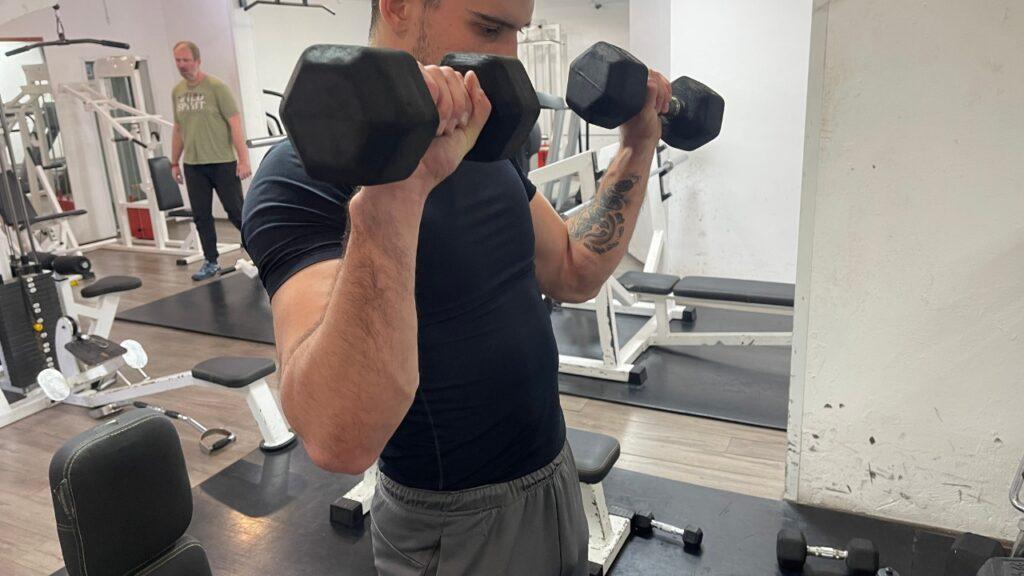
How to Perform Zottman Curls
- Stand straight with dumbbells in your hands with a supine grip, palms facing upwards.
- Curl the dumbbells upward, similar to a regular curl.
- Hold at the top for a second, then rotate your wrists to a prone position, palms facing downward.
- Bring the dumbbells to the starting position and rotate your wrist to a supine grip.
A common mistake people make is either moving their arms back and forth or moving the weights too fast. Fixate your elbows, and do the exercise slowly and with utmost control.
9. Wall Extensions
Wall extensions are bodyweight forearm exercises without any equipment. All you need for this exercise is a wall, so that makes it great for beginners who don’t have gym memberships or equipment at home.
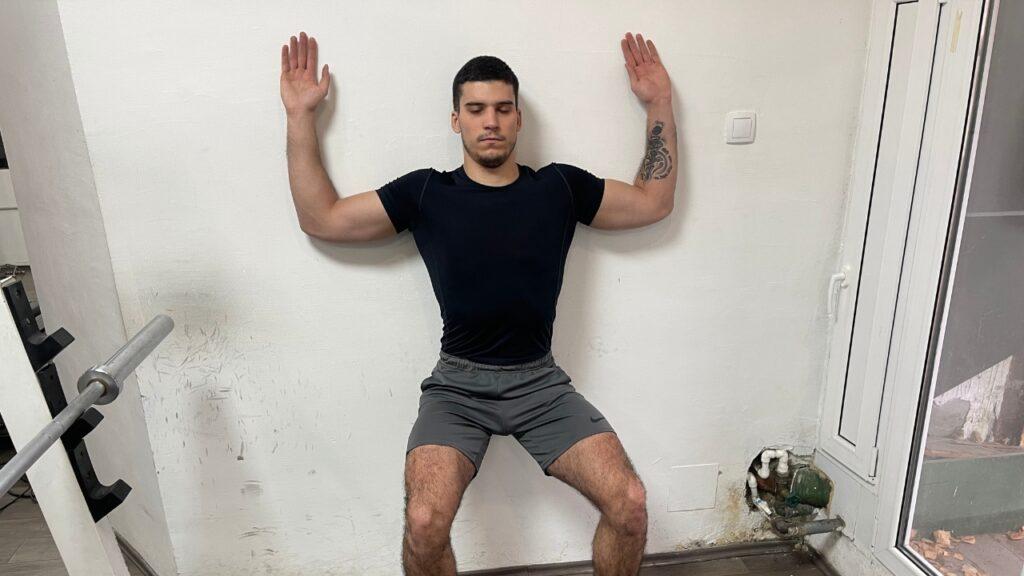
How to Perform Wall Extensions
- Place your back on the wall, bend your legs, and assume a shoulder-width stance with your feet.
- Abduct your shoulders for 90 degrees while also bending the elbows so they enclose a 90-degree angle.
- Slowly abduct your shoulders and extend the elbows to move the hands in the overhead position.
- Hold the top position for one second and squeeze your shoulder blades.
- Reverse the motion to return to the starting position and repeat for the desired amount of reps.
10. Grippers
Grippers were once a popular choice for beefing up forearms and showing off those veins. Even though they might not be the go-to nowadays, they’re still a great tool for forearm development. What makes them cool is that you can use them anywhere, anytime, whether you’re watching TV, working, or just chilling.

Rock Climbing as an Additional Form of Forearm Training
Despite being unusual, rock climbers are known for their insane grip strengths. Either indoors, like climbing gyms, or outdoor rock climbing, you will get an amazing workout for your forearms and back muscles.
One great example is Jason Momoa, an actor known for his role in “Aquaman” and his weird preferences in training. Jason says he hates normal training and going to the gym, but he loves rock climbing. So, his coach had to come up with a workout plan with rock climbing and some other exercises to work his whole body fully.
Rock climbing is an activity that builds endurance and strength in your muscles. Since you have to hold yourself so you don’t fall, your forearms are constantly under pressure.
Some other benefits from rock climbing other than strong forearm muscles are improved coordination, balance, and flexibility, and improved cardio and focus.
Post-Workout Forearm Stretching
I have many friends who question good old stretching routines. However, I am a big believer in stretching for long-term health and stress release. So, here are two stretches that I regularly use and how to do them.
Extensor stretch:
- Extend one arm out with your elbow straight.
- Use the other hand to grasp it at the side of the thumb and bend the wrist downward.
- Hold the stretch for 20-30 seconds.
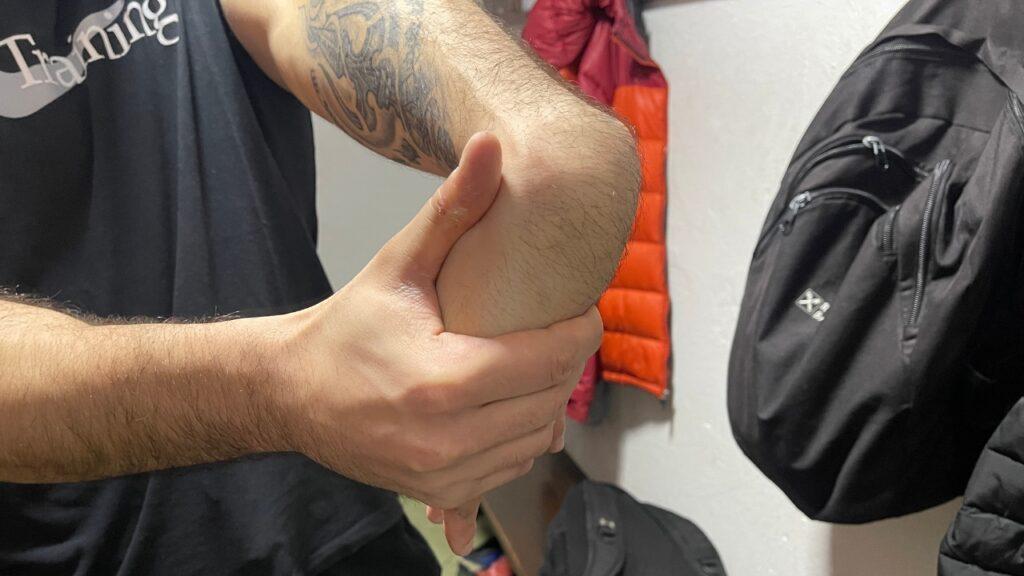
Flexor stretch:
- Hold the palm of one hand with the other hand while keeping your elbow straight on the affected arm.
- Pull your hand back gently to feel a stretch in the forearm.
- Hold the stretch for 20-30 seconds.

FAQs
What Is Functional Rotation of the Forearm?
The functional rotation of the forearm is widely considered to be 50˚ of supination and 50˚ of pronation.
Should I Train My Forearms Everyday?
You shouldn’t train your forearms every day because, as with most muscle groups, the forearm muscles need appropriate recovery time. It is during this recovery time that the muscles actually repair themselves and grow.
Are Forearms Hard to Grow?
Forearms can be hard to grow. Building forearm strength and size can take some time, so be patient. However, with focused efforts, you should see some results in a month or two, at least according to my experience.
How Do I Protect My Wrists When Working Out?
You protect your wrists when working out by having good form and keeping your wrists in neutral alignment. This will reduce the stress on the wrist when gripping.
Is Wrist Size Genetic?
Yes, wrist size is mostly genetic. Wrist size is determined by the size and shape of the bones in the wrist, which are inherited from a person’s parents. However, by working extensively on your forearms, you can see radical improvements in muscle hypertrophy and strength. As with everything else, discipline and consistency are key here.
Why Should You Train Your Forearms?
Despite being relatively small muscle groups, a life without functional forearms would be a nightmare. Forearms play a vital role in daily activities, from simple tasks like eating, drinking, and carrying groceries to more physically demanding activities such as training, pushing, and climbing. However, small in size, forearms contribute significantly to the quality of everyone’s daily life.
Taking it to the extreme, there are situations where your life might depend on the strength of your forearms. For instance, hanging over a cliff with weak forearms and poor grip strength would be the perfect time to think about life. If you don’t train your forearms, you won’t even hang long enough for the important flashbacks.
Furthermore, in more dire scenarios, if someone else is in a life-threatening situation hanging over a cliff, having strong forearms becomes crucial for the potential rescue. While such extreme situations may be unlikely, it raises the question: What’s the worst thing that can happen if you consistently train your forearms correctly?
Start Building Your Dream Body Today
Ready to elevate your fitness game without falling into the trap of dull, repetitive routines that just don’t deliver? Imagine sculpting your ideal physique and boosting your health, all while still enjoying life’s pleasures, like those irresistible weekend getaways and your aunt’s legendary cheesecake. With our online fitness and nutrition coaching service, you don’t have to compromise. Dive into a personalized fitness journey that blends perfectly with your lifestyle, not against it. Book your completely free discovery consultation today, and take the first step towards a transformation that doesn’t require giving up the joys of life.

“I was skeptical about online fitness coaching, but Functional Body Savage completely changed my perspective. Vanja and Radomir’s personalized approach and attention to detail have helped me achieve goals I never thought possible. I’m stronger, more confident, and grateful for their guidance.”
Emily Thompson, San Francisco, CA
Learn More About Our Online Coaching ServiceReferences:
- Plotkin D, Coleman M, Van Every D, et al. Progressive overload without progressing load? The effects of load or repetition progression on muscular adaptations. PeerJ. 2022;10:e14142. Published 2022 Sep 30. doi:10.7717/peerj.14142
- Bohannon RW. Grip Strength: An Indispensable Biomarker For Older Adults. Clin Interv Aging. 2019;14:1681-1691. Published 2019 Oct 1. doi:10.2147/CIA.S194543







